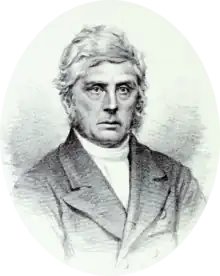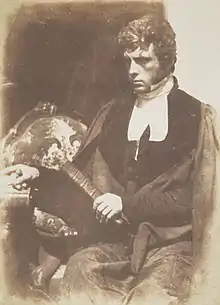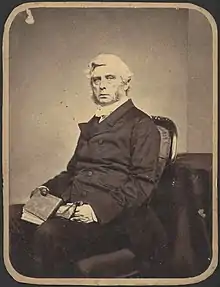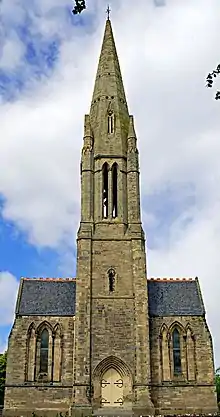Adam Cairns
Adam Cairns (1802–1881) was a Scottish Presbyterian minister. In 1837 he became minister of Cupar. At the disruption in 1843 he sided with the Free Church, and was employed in parochial work until 1853, when he accepted a commission from the Colonial Committee of the Free Church to proceed to Melbourne, where he arrived in September of that year. There, amidst the excitement of the gold fever, he laid the foundations of Presbyterianism in Victoria, acting as pastor of the Chalmers Church Congregation till 1865, when, his health failing, he became an emeritus minister, retaining his standing in the Church without pastoral charge. He died on his birthday January 30, 1881.[4]
Adam Cairns | |
|---|---|
 Adam Cairns from Disruption Worthies[1] | |
| Church | Church of Scotland Free Church of Scotland Presbyterian Church of Victoria |
| Personal details | |
| Born | 30 January 1802 |
| Died | 30 January 1881 |
| assistant minister of St Cuthbert's Church, Edinburgh | |
| In office 1825–1827[2] | |
| minister of Manor | |
| In office 21 August 1828 – 7 April 1833 | |
| minister of Dunbog | |
| In office 7 April 1833 – 1 September 1837 | |
| minister of Cupar | |
| In office 1 September 1837 – 18 May 1843 | |
| minister of Free Church, Cupar-Fife | |
| In office 18 May 1843 – 26 August 1853 | |
| minister of Chalmers Church, Melbourne | |
| In office 1853–1876 | |
| Moderator of General Assembly of the Presbyterian Church of Victoria | |
| In office 1 November 1859 – end | |
| first Principal of the Theological Hall of the Presbyterian Church of Victoria and Professor of Divinity | |
| In office 1865–1873[3] | |
Early life and education



Adam Cairns was born at the manse of Longforgan, on 30 January 1802. Of that parish his father, also called Adam Cairns, was minister for many years.[6] Dr. Cairns’s father appears to have belonged to the parish of Temple. His mother’s father was minister of the parish of Kinnaird, in the Carse of Gowrie.[7] He was descended from a long line of ministers.[1]
Having received the rudimentary part of his education in his native parish, he entered the University of St. Andrews before he was fourteen years of age—too young, as he himself has often confessed. Yet as a student he did more than hold his own among his class-fellows, many of them by far his senior in years. Throughout his whole course of study, both in the University and in the Theological Hall, he occupied a distinguished place. With more than average natural gifts he combined more than average application. He was a hard working student. Of himself he has been heard to say, “I have no great natural ability; and any measure of success to which I have attained has been won through hard labour and close application to present duty.”[1]
He was licensed as a preacher by the Presbytery of Cupar on 5 October 1824.[3] Soon after this, he passed through a severe ordeal, which lasted for several years. His health at this stage suffered greatly, and threatened for a time entirely to give way. Cast on his own resources, he was obliged to support himself by private teaching. In various ways his strength was overtaxed; he was in a state of physical exhaustion, nervous and irritable.[1]
Early ministry
After serving for a time as assistant to Henry Moncreiff, minister of the parish of St. Cuthbert’s, Edinburgh, Cairns was presented to the parish of Manor, in the county of Peebles, where he was ordained on 21 August 1828.[8][3] The parish is a quiet pastoral valley and for four years and a-half he went in and out among them.[1]
But now his work in this his first charge was drawing to a close. His health was again seriously affected. His old complaint returned upon him. It was brought on, or at all events accelerated, by the illness of a brother, who had returned from America in quest of health. Having come to reside at the manse at Manor, Mr. Cairns was unremitting in his attention to him. The complaint in his brother’s case got worse. He died. The care and anxiety of waiting at that death-bed left serious effects on Cairns’s own health. And just at the time when a change was desirable, he received a presentation to the parish of Dunbog, in the north-west of Fife. Feeling it to be his duty to accept the offer, he was inducted into that charge, on 7 April 1833. [9] Being strictly a rural parish, the work was easy. It gave the opportunity for recruiting his shattered health. It was here, and on 11 February 1834, that Cairns was married to Miss Jessie Ballingall.[1] After a successful ministry in his second charge of about equal duration with that of his first, Mr. Cairns was translated to Cupar-Fife.[3]
Ministry in Cupar
It was a collegiate charge. He was inducted on 1 September 1837.[3] In the midst of his labour his strength again gave way. For months his life hung quivering in the balance. He was an invalid for years.[1] Again there is another break, and it seemed at the time that his ministry was at end. At the Disruption in 1843 he sided with the Free Church. In November 1847, during the afternoon service, he was struck down in the pulpit. He was carried to the vestry, and there laid down as a dying man. Contrary to expectation, he soon recovered. Having gone to Gibraltar, in the hope that the climate there would renovate his shattered system, and feeling greatly benefited by the change, he hired a hall in the principal street, where he preached morning and evening, the morning attendance being always crowded. The Free Church minister of Cupar was able to contribute, to the current literature of the day. In view of this, and in particular, in recognition of an able and interesting volume produced by him, entitled "The Second Woe", the Senatus of St. Andrews University conferred on him the degree of D.D. on 9 April 1853.[3][1]
Move to Australia
The gold discovery in Australia was attracting universal interest and migrants were landing daily there in thousands. The Free Church determined to strengthen the hands of the ministers already in Australia, by sending immediately other ten or twelve at least. Ten young men gave their consent to go. They were but newly licensed, and though now to be ordained, they had no experience. It was needful, therefore, to secure along with them one or two ministers of standing and experience. Two such men were Mackintosh Mackay, of Dunoon, and the other the Rev. Dr. Cairns, of Cupar.[1]
The twelve ministers, sailing some together, and others singly, in different vessels, all arrived safely in Australia. The sphere assigned to Dr. Cairns was Melbourne. It was then in a state of strange transition; passing from a small town into the dimensions of a great and populous city. There were two congregations of the Free Church in Melbourne at the time, but only one church, the second congregation worshipping in a rented hall. Cairns at once commenced his labours, preaching in the Temperance Hall in the forenoon, and in Knox’s Church in the evening. A large congregation sprang into existence at once. It was one of the largest in the southern hemisphere. From his first public appearance it was felt by all classes that he was to wield an immense power in the colony. On a valuable piece of ground on the Eastern Hill, granted by the Government, a large wooden erection was hastily run up, which served as a church for two or three years, until a more substantial building was erected. Here Dr. Cairns ministered to a large and attached congregation for more than twenty years. In 1876 he demitted his charge, constrained to do so on account of advancing years and failing strength.[1]
He died at home in Richmond, Melbourne on 30 January 1881.
Works
- Some Objections to Universal Atonement Stated and the Current Objections to a Particular and Efficacious Atonement considered, two discourses (Cupar, 1844)
- On the Origin and Obligation of the Sabbath, being No. 1, Sermons on the Sabbath (Dundee, 1847)
- Account of Dunbog (New Statistical Account, ix.)[10]
- The Second Woe (Edinburgh, 1852)[11]
- Sermon LXIII. (Free Church Pulpit, ii.)[3]
Family
He married 11 February 1834, Jessie (died 26 August 1906), daughter of — Ballingall, Ayton, and had issue —
- Margaret, born 26 August 1835
- Elizabeth, born 25 February 1837
- Jessie, born 5 September 1840
- Ebenezer Adam, born 8 January 1843[3]
See also
References
Citations
- Wylie 1881.
- ADB online 1969.
- Scott 1925.
- Mennell 1892.
- EMHS images 2022.
- Scott 1925, p. 353.
- Scott 1925, p. 346.
- Scott 1915.
- Scott 1925, p. 151.
- Cairns 1845.
- Cairns 1852.
Sources
- Balfour, R. Gordon (1899). "Lecture 4 - II Presbyterianism in Victoria". Presbyterianism in the colonies, with special reference to the principles and influence of the Free church of Scotland . Edinburgh: Macniven & Wallace. pp. 119-171.
- Brown, Thomas (1893). Annals of the disruption with extracts from the narratives of ministers who left the Scottish establishment in 1843 by Thomas Brown. Edinburgh: Macniven & Wallace. pp. 568, et passim.
- Cairns, Adam (1845). "Parish of Dunbog". The new statistical account of Scotland. Vol. 9. Edinburgh and London: William Blackwood and Sons. pp. 205-217.
- Cairns, Adam (1852). The Second Woe; a Popular Exposition of the Tenth and Eleventh Chapters of Revelation, Showing that the Theory of the Rev. Mr. Elliott, and the Author of the "Seventh Vial," as to the Death and Resurrection of the Witnesses, is Inconsistent Both with Prophetic Scripture and Profane History. Edinburgh: Johnstone & Hunter.
- Cairns, Adam (1854a). England's Policy and Prospects in connection with the Eastern War: a discourse, etc. Melbourne: Hugh M'Coll.
- Cairns, Adam (1854b). The Jews; Their Fall and Restoration. Two Discourses, Etc. Melbourne: J. J. Blundell & Company.
- Cairns, Adam (1856a). New Year's Sermon; with remarks suggested by the decease of ... Sir Charles Hotham. Melbourne: Wilson, Mackinnon & Fairfax.
- Cairns, Adam (1856b). The Dangers and Duties of the Young Men of Victoria ... Lecture Delivered Before the Victoria Early Closing Association, Etc. Melbourne: Wilson, Mackinnon & Fairfax.
- Cairns, Adam (1856c). Church and State. A lecture, etc. Melbourne: Wilson, Mackinnon & Fairfax.
- Cairns, Adam (1856d). The Inauguration of the Political Independence of Victoria ... A Lecture, Etc. Melbourne: Wilson, Mackinnon & Fairfax.
- Cairns, Adam (1866). Inaugural Address delivered at the opening of the Theological Hall of the Presbyterian Church of Victoria, etc. Melbourne: A. J. Smith.
- Campbell, Alexander James (1889). 50 Years of Presbyterianism in Victoria. M. L. Hutchinson. p. 132.
- Chambers, Don (1969). "Cairns, Adam (1802–1881)". Australian Dictionary of Biography. Vol. 3. National Centre of Biography, Australian National University. p. 76. ISSN 1833-7538.
- Hamilton, R. W. (1888). A jubilee history of the Presbyterian Church of Victoria; or, the rise and progress of Presbyterianism from the foundation of the colony to 1888. Melbourne: M.L. Hutchinson. pp. 78et passim.
- Mennell, Philip (1892). "Cairns, Rev. Adam". The Dictionary of Australasian Biography. London: Hutchinson & Co. p. 76 – via Wikisource.
 This article incorporates text from this source, which is in the public domain.
This article incorporates text from this source, which is in the public domain. - Philip, Adam (1895). The parish of Longforgan; a sketch of its church and people. Edinburgh: Oliphant, Anderson & Ferrier. pp. 247-259.
- Scott, Hew (1915). Fasti ecclesiae scoticanae; the succession of ministers in the Church of Scotland from the reformation. Vol. 1. Edinburgh: Oliver and Boyd. p. 283.
 This article incorporates text from this source, which is in the public domain.
This article incorporates text from this source, which is in the public domain. - Scott, Hew (1925). Fasti ecclesiae scoticanae; the succession of ministers in the Church of Scotland from the reformation. Vol. 5. Edinburgh: Oliver and Boyd. p. 145,151,353,346,356.
 This article incorporates text from this source, which is in the public domain.
This article incorporates text from this source, which is in the public domain. - Scott, Hew (1928). Fasti ecclesiae scoticanae; the succession of ministers in the Church of Scotland from the reformation. Vol. 7. Edinburgh: Oliver and Boyd. p. 586.
 This article incorporates text from this source, which is in the public domain.
This article incorporates text from this source, which is in the public domain. - Stewart, D. Macrae (1909). The Presbyterian Church of Victoria : growth in fifty years, 1859-1909 / issued by authority of the General Assembly by D. Macrae Stewart. Melbourne: Paterson. pp. 31-32.
- Sutherland, Robert (1877). The History of the Presbyterian Church of Victoria From the Foundation of the Colony Down to the Abolition of State Aid in 1875. London: James Nisbet. pp. 123et passim.
- Walker, David (1876). "Chapter X - The Rev. John Laird, Free Church, Cupar". The Fife pulpit: a series of sketches of a number of ministers of various denominations, repr. from The Fife advertiser, enlarged [&c.]. Dysart: David Walker. pp. 93-101.
- Wylie, James Aitken, ed. (1881). Disruption worthies : a memorial of 1843, with an historical sketch of the free church of Scotland from 1843 down to the present time. Edinburgh: T. C. Jack. pp. 117–124.
 This article incorporates text from this source, which is in the public domain.
This article incorporates text from this source, which is in the public domain. - "1865 Dr. Adam Cairns by Henry Samuel Sadd". East Melbourne Historical Society.